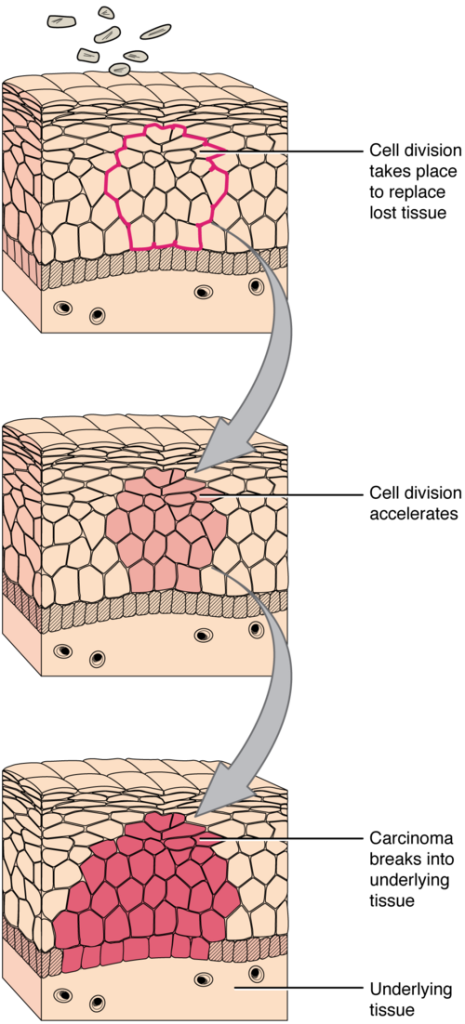4.3 Tissue Disorders
Lupus
Lupus is a disease that occurs when your body’s immune system attacks your own tissues and organs (autoimmune disease). Inflammation caused by lupus can affect many different body systems, including joints, skin, kidneys, blood cells, brain, heart and lungs. Lupus can be difficult to diagnose because its signs and symptoms often mimic those of other ailments. The most distinctive sign of lupus — a facial rash that resembles the wings of a butterfly unfolding across both cheeks — occurs in many but not all cases of lupus. Some people are born with a tendency toward developing lupus, which may be triggered by infections, certain drugs, or even sunlight. While there’s no cure for lupus, treatments can help control symptoms.[1]
Marfan’s Syndrome
Marfan syndrome is an inherited disorder that affects connective tissue, the fibers that support and anchor your organs and other structures in your body. Marfan syndrome most commonly affects the heart, eyes, blood vessels and skeleton. People with Marfan syndrome are usually tall and thin with unusually long arms, legs, fingers, and toes. The damage caused by Marfan syndrome can be mild or severe. If the aorta — the large blood vessel that carries blood from your heart to the rest of your body — is affected, the condition can become life-threatening. Treatment usually includes medications to keep blood pressure low to reduce the strain on the aorta. Regular monitoring to check for damage progression is vital. Many people with Marfan syndrome eventually require preventive surgery to repair the aorta.[2]
Tissues and Cancer
Cancer is a generic term for many diseases in which cells escape regulatory signals. Uncontrolled growth, invasion into adjacent tissues, and colonization of other organs, if not treated early enough, are its hallmarks. Health suffers when tumors “rob” blood supply from the “normal” organs.
A mutation is defined as a permanent change in the DNA of a cell. Changes in DNA may be caused by environmental agents, infectious agents, or errors in the replication of DNA that can accumulate with age. Many mutations do not cause any noticeable change in the functions of a cell. However, some mutations may cause a cell to start to divide abnormally. A tumor, a mass of abnormal cells, forms in the tissue. Many tumors are benign, meaning they do not metastasize (spread) or cause disease. A tumor becomes malignant, or cancerous, when it grows beyond its tissue and metastasizes to other organs. See Figure 4.16[3] for an illustration of the development of cancer.

The specific names of cancers reflect the tissue of origin. Cancers derived from epithelial cells are referred to as carcinomas. Cancer in myeloid tissue or blood cells form myelomas. Leukemias are cancers of white blood cells, whereas sarcomas derive from connective tissue.
Cancer treatments vary depending on the disease’s type and stage. Traditional approaches, including surgery, radiation, chemotherapy, and hormonal therapy, aim to remove or kill rapidly dividing cancer cells.
View this supplementary YouTube video[4] to learn more about tumors: 3D Medical Animation – What is Cancer?.
- Mayo Clinic. (2022). Lupus. https://www.mayoclinic.org/diseases-conditions/lupus/symptoms-causes/syc-20365789 ↵
- Mayo Clinic. (2022). Marfan syndrome. https://www.mayoclinic.org/diseases-conditions/marfan-syndrome/symptoms-causes/syc-20350782 ↵
- "418_Development_of_Cancer" by OpenStax College is licensed under CC BY 3.0 ↵
- BioDigital, Inc.. (2008, October 14). 3D medical animation - what is cancer? [Video]. YouTube. All rights reserved. https://www.youtube.com/watch?v=LEpTTolebqo ↵
A disease that occurs when your body's immune system attacks your own tissues and organs (autoimmune disease).
An inherited disorder that affects connective tissue.
A generic term for many diseases in which cells escape regulatory signals.
Cancer is a generic term for many diseases in which cells escape regulatory signals.
Cancers derived from epithelial cells.
Cancer in myeloid tissue or blood cells.
Cancers of white blood cells.
Cancers of the connective tissue.

